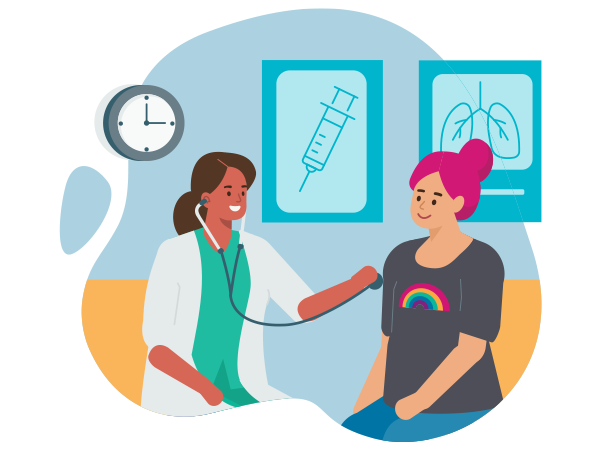
Phreesia survey data shows that LGBTQ+ patients experience inequities in knowledge and usage of preventive health services.
Members of the lesbian, gay, bisexual, transgender and queer and/or questioning (LGBTQ+) community face unique challenges and biases when it comes to accessing preventive care. And because of these barriers, one-quarter of surveyed patients who self-identify as LGBTQ+ said they felt “not at all confident” they knew what preventive screenings they might currently need, according to survey data Phreesia Life Sciences and Klick Health collected from more than 1,500 patients in early 2022.
In a recent webinar, Amy Gómez, PhD, SVP, Diversity Strategy, Klick; Heath Morlok, Associate Director, Oncology, Integrated Customer Engagement, Merck; and Thea Briggs, Associate Director, Content Strategy, Phreesia Life Sciences, discussed some of the issues affecting LGBTQ+ preventive health access.
Here are three ways pharma marketers can boost preventive care among LGBTQ+ patients:
1. Acknowledge and address inequities that LGBTQ+ patients experience in medical settings
Members of the LGBTQ+ community face healthcare access barriers, such as higher rates of being either uninsured or underinsured. Apart from these challenges, this patient population also experiences discrimination in medical settings, and there are many patients who are treated in ways that make them feel uncomfortable or unsafe, explains Gómez.
“In fact, it’s not that uncommon for transgender people to have to educate [their] own HCP on their needs, which doesn’t exactly inspire trust,” she says. “In other cases, patients are being refused care for their actual or perceived identity. And again, this is particularly high in the transgender community. All of this has a negative impact on preventive care.”
Bias also appears within screening; for example, HCPs might talk about HIV screening for their patients who they perceive as being at greater risk for that condition and prioritize it over information on screenings for other conditions, such as high blood pressure or cancer. When asked which screenings their doctor had mentioned to them over the past two years, 30% of LGBTQ+ patients listed HIV, 33% listed sexually transmitted diseases and 25% listed depression, making them the three most-recommended screening suggestions. Yet, routine cancer checks were each recommended to well below half of eligible LGBTQ+ patients, according to survey data from Phreesia and Klick.
2. Increase HCPs’ awareness of LGBTQ+ preventive health gaps
There’s a general assumption that the LGBTQ+ community has overcome disparities such as gaps in preventive care, Morlok explains. However, this is far from the case given that LGBTQ+ patients have inadequate preventive care discussions with their doctors and aren’t getting screening reminders from their providers’ offices. Just 45% of these patients said they got preventive health reminder messages from their doctor’s office, compared with 64% of the overall population, survey data shows. The industry needs to recognize that there is still a lot of work to do in terms of awareness, starting with ensuring HCPs know when their patients identify as part of the LGBTQ+ community and what it means for their healthcare.
“[The LGBTQ+ community] is one of the fewer minority groups where that kind of identity/minority status isn’t readily obvious upon walking in the door and sitting down in an exam room,” Morlok says. “… I’ve realized I’ve never once been asked by any of my physicians if I identify with a portion of the LGBTQ+ community. And although I check off every medicine I’m allergic to, every condition that I’ve had, how many drinks I drink, how many times I smoke—I’ve never once checked a box asking my sexual identity or my gender identity.”
Without asking patients for their self-identification, Briggs says that physicians may not even recognize when their patient belongs to the LGBTQ+ community, or that this translates to gaps in preventive health measures. Survey results show that physicians seldom bring up preventive care with LGBTQ+ patients, with 67% reporting their doctor never brought up cancer screenings with them within the last two years, including 48% of LGBTQ+ patients over 45 years old.
“If you can’t have an open dialogue with your physician, there may be conversations you should be having that you’re not,” Briggs says. “[Patients and providers] need to come together to have these productive conversations. It’s just going to be a necessary part of boosting rates of preventive care items like cancer screening and immunization.”
3. Create materials and tailor messaging to support and resonate with the LGBTQ+ community
To help educate physicians on the issues LGBTQ+ patients experience, Gómez recommends creating resources such as patient discussion guides, which would be designed for the provider to better support their conversations with LGBTQ+ patients. The materials would ideally model to HCPs what it looks like to have bias-free, non-judgmental conversations that cover all of LGBTQ+ patients’ medical and preventive healthcare needs.
And while visual representation is a big component of advertising, less than half (44%) of surveyed LGBTQ+ patients agreed that pharma ads reflect their experience as a member of the LGBTQ+ community. To connect and resonate with this patient population, healthcare marketers must embrace cross-cultural marketing practices.
“Cross-cultural marketing, when it’s done right, is a strategic, insight-driven discipline that is all about understanding the attitudes, the beliefs, the behaviors, the unmet needs of your audience,” Gómez says. “That means starting from research. If you want to tailor a message that is authentic so that it’s relevant, we have to be super thoughtful and deliberate about including LGBTQ+ individuals in our market research.”
Learn how Phreesia can help you reach and activate relevant patients by delivering tailored content at the right moments in their healthcare journey.


